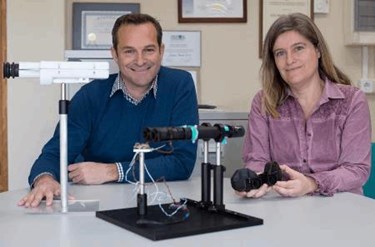Handheld Device Lets Patients "Test-Drive" Lens Implants

A new handheld device may better equip patients in their decision-making process when choosing an intraocular lens (IOL) implant. The SimVis, developed by Spanish scientists, was tested with cataract surgery candidates, and researchers found patients had a clear preference for certain implants based on their experiences with the device.
IOL implants are used to replace the eye’s natural lens, which has clouded over with a cataract. Depending on a patient’s individual needs, lifestyle choices, and cost requirements, there are many different IOLs currently available. Monofocal lenses — the most common choice, according to the Academy of American Opthalmology (AAO) — are set to correct vision at either near, intermediate, or far-away distances, and patients who choose this lens must use glasses to correct their vision for other distances. Premium lenses, such as accommodative, multifocal, or toric IOLs, allow for further options and lessen the need for patients to supplement their vision with glasses.
According to the AAO, eye surgeons measure a patient’s eye and assist in the decision-making process using their own experience and judgement, paired with the patient’s wants and needs. Now, scientists from the Instituto de Optica at the Consejo Superior de Investigaciones Clientificas (CSIC) in Spain want to give cataract patients an additional tool to help them make the best decision.
“There are many different intraocular lenses in the market which provide different balances of near and far vision,” said Aiswaryah Radhakrishan, a researcher at CSIC. “We have discovered a way to simulate these intraocular lenses and demonstrated a prototype device that allows patients to test different solutions before surgery.”
CSIC researchers described their prototype in a study recently published by Optica. The “hand-held, see-through multifocal vision simulator” uses an electrical current to adjust a tunable lens. According to the researchers, the device was easy to use, provided easily reproducible results, and allowed nine patients to test monofocal, bifocal, and trifocal corrections with different far/intermediate/near distributions. The researchers commented that the device could take the place of expensive testing, bulky equipment, and risky revision surgeries if the implanted IOL is unsatisfactory.
“The favored or rejected lenses were different for different testers, suggesting the need for this kind of simulation prior to surgery to customize the selection of lenses according to patient requirements,” said Carlos Dorronsoro, first author of the study, in a press release. “Clinical use of the SimVis could provide an evidence-based way to assess the subjective needs and preferences of patients before they undergo cataract surgery.”
CSIC researchers are working on a smaller, second-generation prototype of the device, which will look more like a virtual reality helmet and offer a wider field of vision. The team currently is at work on clinical validations, and is hoping for a commercial SimVis launch as early as 2017.
Approximately 24.5 million Americans have cataracts, according to the AAO, and more patients are electing to have cataract surgery each year, and at younger ages. Over two million procedures are done each year, and that number is expected to increase. By 2050, the AAO projects 50 million Americans will be diagnosed with cataracts.
